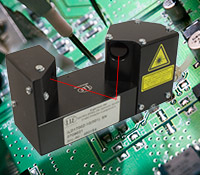( Micro-Epsilon: Raleigh, NC) -- Whatever doesn’t fit will be made to fit. This statement could have been the thought when the optoNCDT 1700Z-10 sensor was developed. It functions in a similar way to a conventional sensor. However, the transmitter is detached from the receiver. The sensor obeys the usual laws of triangulation, but in this case there can be an object between the transmitter and receiver. Measurements are performed directly at the point of action. Exactly where a tool or a lens must be positioned. Due to the special design, the sensor measures on matte, diffuse, reflecting, and glass surfaces.
Micro-Epsilon: Raleigh, NC) -- Whatever doesn’t fit will be made to fit. This statement could have been the thought when the optoNCDT 1700Z-10 sensor was developed. It functions in a similar way to a conventional sensor. However, the transmitter is detached from the receiver. The sensor obeys the usual laws of triangulation, but in this case there can be an object between the transmitter and receiver. Measurements are performed directly at the point of action. Exactly where a tool or a lens must be positioned. Due to the special design, the sensor measures on matte, diffuse, reflecting, and glass surfaces.
Applications for the z-sensor can be found in medical technology, where pipettes need to be positioned very precisely to a carrier plate. The optoNCDT 1700z-10 is also used in exposure machines in the printing industry. Here, precise positioning of exposure lenses to matte offset plates as well as blank printing films is required. Direct measurement in the focus position of the lens also enables even better edge exclusion yield of the materials to be exposed, as measuring indirectly next to it no longer has to be performed.
…
Add new comment